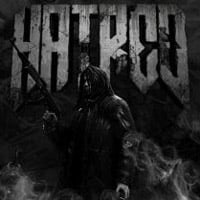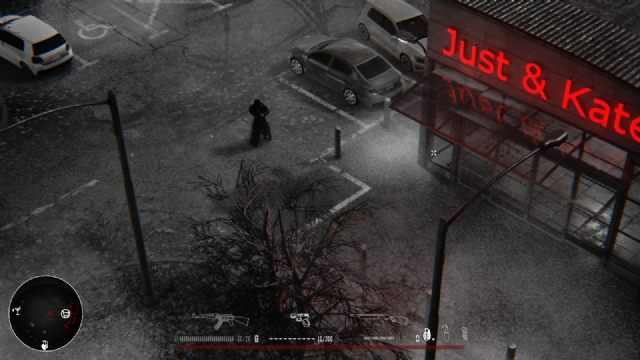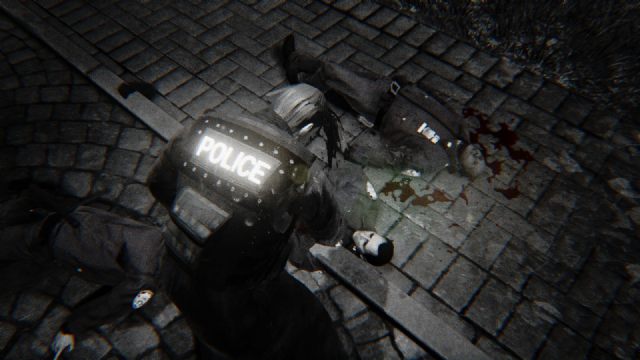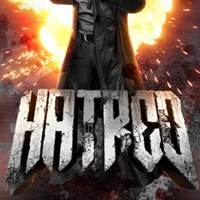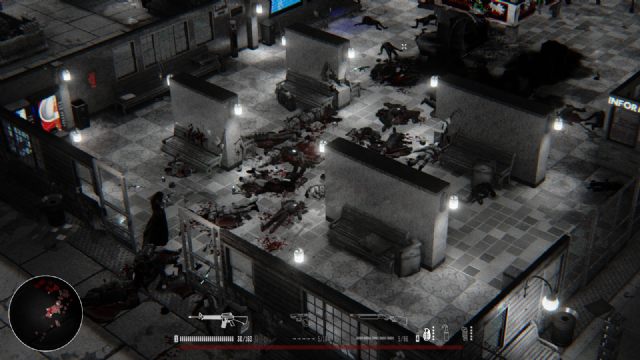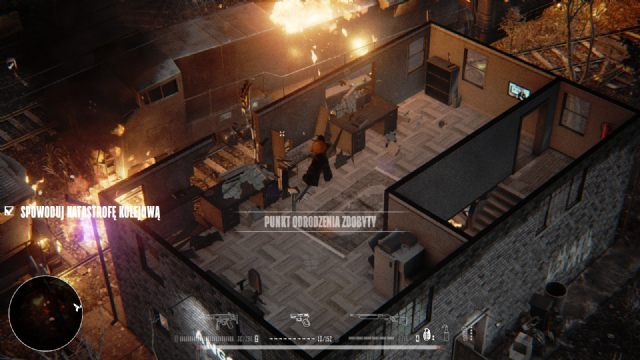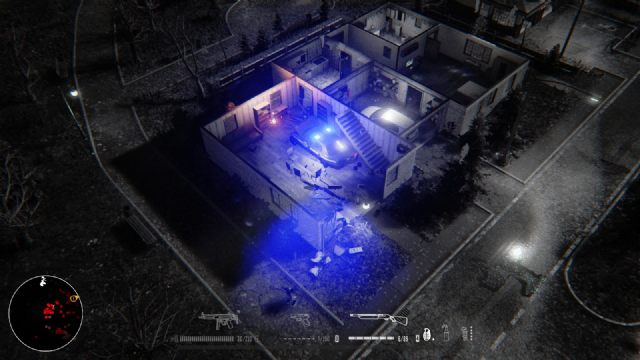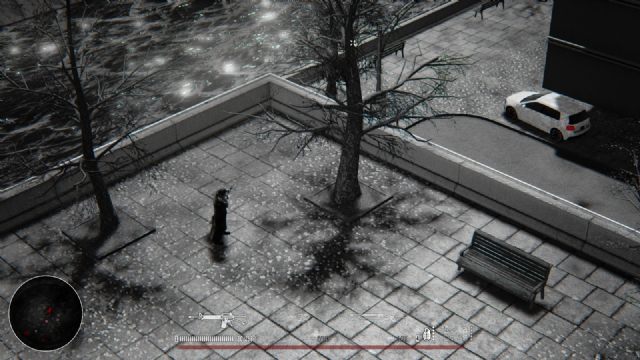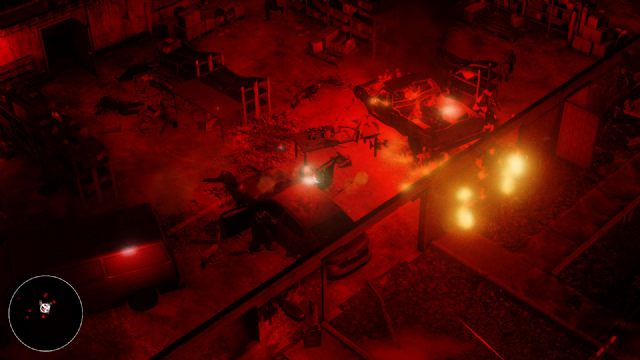Hatred Review: The Controversial "Polish Postal" Is Decent, But Far From Perfect
Hatred has finally hit the market. Let's see if beneath the thick layer of blood hides a game that will be remembered not only by the outraged moral guardians, but also by gamers.
The review is based on the PC version.

- Satisfactory and demanding combat system with some unusual solutions;
- Nice graphics with a spectacular destruction of environment;
- Suggestive, heavy atmosphere, acquired through dark graphic style and sound;
- Most of the locations have an open structure and offer additional tasks and vehicles.
- We could use more levels, weapons, and enemies;
- Very poor optimization;
- Daft artificial intelligence;
- Occasional problems with control system, illegible environment, and glitches;
- The plot could be richer.
It was a busy night – or rather six hours. I demolished a sizeable chunk of the United States, fired almost sixteen thousand bullets, and massacred nearly two thousand people: civilians, policemen and soldiers. But don't get me wrong – it wasn’t a merry rampage. Although the creators of Hatred, Polish studio Destructive Creations debuting as developer, did their best to build a substantial hype around the production due to its uncompromising brutality, they also made sure that nobody would get an impression that they’re dealing with an isometric version of Serious Sam – something equally funny and carefree, just in a different setting. Although I feel a nice, satisfying rush of adrenaline after these six hours – which is how the player should feel after a session spent with a good shooter – there is no doubt in my mind that I took part in a genocide, and because of that I am experiencing a certain level of discomfort. I'm not going to dwell on the ethical aspect of Hatred – partaking in a debate on whether the creation of productions with such heavy themes is appropriate can be done elsewhere. In this review I will focus solely on the game itself – and it's the game itself that was given the rating seen above, regardless of the themes it features.
"My name is not important..."
People who haven't heard of the game until now deserve a few words of introduction. Hatred is an isometric shooter, whose main theme revolves around committing mass murder. The plot is pushed to the side and only serves as a pretext for killing everyone that crosses our path. The player assumes the role of a mysterious psychopath who harbors a feeling of deep hatred towards the whole world and intends to put an end to it – or at least the part of it that's in his nearest vicinity. When we meet him, he's busy gearing up at his house only to leave soon and set off a bloody shooting spree. From that moment on, we control his actions and help him complete the "mission" he designed for himself. And that's about the whole story – throughout the game we learn nothing about our antihero, and we certainly don't discover the reasons that pushed him to commit his crimes. And although personally I wouldn't mind some more depth to the narrative, I understand that the developers didn't want to distract the player from what's most important in Hatred – and that is pure action.
Mass killing at a moderate pace
Although Hatred offers a low level of difficulty, it is clear that the creators direct their product to seasoned players. And it's not even about the fact that the easy level is in fact not so simple. Before one decides to choose it, they should keep in mind that completing the game in this difficulty mode is awarded with the "C***" achievement – as you probably guessed, it refers to a rather vulgar term for a specific part of a woman's anatomy.
You must know, however, that the debut work of Destructive Creations does not offer a mayhem as uncompromising as the promotional materials might suggest. Our character is hardly a bullet-proof tank, and since most opponents attack in groups it's always better to remain careful. While playing on the second of the three difficulty levels (i.e hard, the remaining two being easy and extreme), I was forced to progress slowly as early as in the second of the seven missions, every now and then glancing at the minimap in search of enemies, and crouching at the slightest sign of danger (to reduce my vulnerability to opponents’ hits), ready to shoot at everything that emerged from behind the edge of the screen. I was also eager to use covers, which sometimes made the gameplay reminiscent of Gears of War.
This doesn’t mean, however, that confrontations in Hatred are sluggish. In open space, the antihero is usually approached by the opponents from different sides, and so he must flee manhunts by somersaults and seek a safe position to shoot. This movement-based approach is also encouraged by the system of life renewal, which is one of the most original and controversial parts of the game. We won’t find automatic health regeneration or the classic first aid kits – the only way the villain can heal is by finishing off dying NPCs via brutal executions. This leads to situations where we are trying to use a limited number of bullets on our targets (so as not to do them in immediately), or defend against enemies in places full of civilians as they may be used at any time as a "living first aid kit".
Overall, the combat system looks very good. Confrontations are demanding and provide a lot of satisfaction, and the rather rich variety of moves available to our antihero (even including kicks) combined with a couple of interesting solutions – such as the above-mentioned method of life regeneration – make the exchange of fire continuously engaging almost to the very end of our "adventure". Much of the credit is due to Unreal Engine 4 guaranteeing an environment that is prone to destruction and acts according to the rules of physics. Grenades scatter various appliances and tear the walls apart, bullets chop through covers making them more and more useless – in terms of the destruction of environment Hatred can compete with the Battlefield series. I often found myself firing at exploding barrels just to see how a structure composed of small rooms becomes an open space, filled with rubble and burning up in flames.
A psychopath’s sandbox
Let’s go back to the issue of the difficulty level. Reckless charging towards the enemies is also discouraged by the saved game system within a mission... or rather, the lack thereof. Death usually means that we have to repeat an entire level, and these take on average several dozen minutes. In the long run, going back to the start can become quite frustrating. Fortunately, we have a chance to gain so-called rebirth points by completing various additional objectives. They allow us to come back to life in a remote corner of the site without resetting the progress of the task at hand. This is where we come to yet another interesting feature of Hatred – most missions take place on sizeable maps with an open structure. In many cases, the game presents us with a general objective such as "Kill 60 civilians", leaving us complete freedom as to the methods of its execution. Icons appear on the radar showing us places worth checking out – that's where we find additional tasks awarded with rebirth points.

Despite the heavy atmosphere, the creators smuggled in a few tidbits that somewhat lighten the serious character of their work. This applies especially to the achievements on Steam, bearing names like "Bay would be proud" (awarded for causing explosions) or "Can-opener" (for disposing of SWAT team members). The end credits also contain a hint of black humor – the developer declares in capital letters that he thanks no one and tells everyone to go f*** themselves, with the notable exception of "Lord Gaben", the fans, and all those who helped create Hatred. What’s more, there's a special option in the configuration menu prepared for the players who start their session in the game in a state of intoxication.
Unfortunately, these objectives lack diversity – in most cases we just exterminate people gathered at a particular point (e.g. hipsters crowding at the premiere of "A-Phone" in a mobile device showroom, or hunters in the woods). Luckily, the diversity present in the next levels saves us from monotony – we get to sow death and destruction not only in towns but also in the sewers, on a train, and in a military base. What's interesting, some of the maps are so vast that we can even traverse them with cars. Once we get behind the wheel, the game begins to resemble the first installments of the Grand Theft Auto series. The size of the visited areas also means that sometimes we're going to get lost – an implementation of a map could be a good idea.
Through the eyes of a madman
As I mentioned in the introduction, Destructive Creations made every effort to ensure that no one would mistake genocide for a Sunday picnic. Thanks to evocative graphic design, Hatred's gameplay simply can’t be treated as embarking on a fun ‘killer’ adventure. The entire game world is shrouded in shades of gray with the exception of blood and light sources which have their natural colors. We are accompanied by a soundtrack composed of heavy ambient music and the desperate screams of the people we murder, making it impossible to forget for even a moment that we control the actions of a psychopath and participate in his murderous madness. Our antihero himself tries his best to deter anyone from liking him delivering lines that express deep contempt for the victims of his bloodlust as well as demented joy at the sight of his handiwork. In short, despite all the satisfaction that comes from combat, Hatred can still remain a rather disturbing experience for the player.
A big fat fly in the ointment
Although the fundament of Hatred, built upon its combat system and atmosphere, is a very solid construction, Destructive Creations made many mistakes that have a rather harmful effect on the overall assessment of their debut work. First of all, the production could be longer – I took me about six hours to complete it, but a quicker player could do this in five hours or less. What's more, we won't experience any additional forms of entertainment (e.g. a challenge mode), which would elongate this time. The longevity of the game could increase if any items were located on the map for us to find, or if a character or weapon development system were implemented; sadly, we won't find anything of the sort. The available arsenal and the variety of enemies are hardly satisfying – there are only several models of common weapons (pistol, shotgun, a couple of rifle models, grenades etc.), and we’re pitted against policemen, members of the SWAT team, and soldiers. We can’t even count on confrontations with bosses. And although the content is sufficient not to bore us much during a single game session, I can’t imagine that anyone would want to complete Hatred several times.
Another issue comes in the form of exaggerated hardware requirements. I tested the game on a fairly powerful computer (Core i5-4570 (3.2 GHz), 8 GB RAM, Radeon R9 270) and even using the settings ranging between high and ultra I only managed to get an average of 25-30 frames per second (not counting the quieter moments, but these are rather scarce). This is a very poor result, especially considering that The Witcher 3: Wild Hunt in a similar configuration on the same machine gives a great result of 40-50 frames. I also have to mention the dramatic frame drops during execution scenes – up to 17-18 FPS – and the fairly long loading screens (although the latter we don’t see often).
The artificial intelligence of the enemies is not impressive, either. As mentioned, the opponents can approach our villain from the side; still, apart from implementing clever tactics every once in a while, they also tend to exhibit a completely numb and passive attitude, especially when defending themselves from a ranged attack. In addition, they cope poorly with the use of shields, and often don't care at all about any obstacles on the line of fire, including their own companions or exploding containers. What’s more, the characters sometimes get stuck on obstacles (this also happens to our antihero). This is mostly due to the artistic design – its monochromatic character makes it easy to get stuck on the hardly noticeable elements of the environment in cramped surroundings.
The verdict: definitely far from hatred
To sum up, the debut of Destructive Creations led by CEO Jaroslaw Zielinski deserves a positive rating. Hatred is most definitely a playable product, which should satisfy gamers seeking adrenaline and intense emotions. Does Hatred live up to the media hype that has surrounded it for a while now? As for the game alone, not really – it's good, but it's still a rather modest production, which is unlikely to go down in the history of gaming industry... Unless the fuss around the violence in the game becomes much stronger after the premiere than it was in the recent months. It seems that time will tell.
Hatred
Hatred Review: The Controversial "Polish Postal" Is Decent, But Far From Perfect
Hatred has finally hit the market. Let's see if beneath the thick layer of blood hides a game that will be remembered not only by the outraged moral guardians, but also by gamers.
